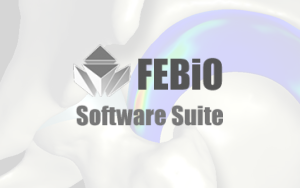 The Scientific Computing and Imaging Institute and the Musculoskeletal Research Laboratories are proud to announce the 1.0 release of the software FEBio, "Finite Elements for Biomechanics". FEBio is a nonlinear finite element software package that is specifically designed to address problems in computational biomechanics. Some of the features of note include capabilities for contact, rigid bodies and kinematic joints, nonlinear anisotropic constitutive models, simulation of active contraction, poroelasticity, element formulations for nearly-incompressible materials and parallel solution of the linear system of equations. After extensive testing in our lab and with our collaborators, we are happy to offer this free software to the research community. FEBio is currently available for WindowsXP, MacOS/X, Suse Linux (64 bit Opteron/Athlon64) and SGI Altix (64 bit Itanium2). We would be happy to port FEBio to other Unix/Linux platforms. The FEBio distribution includes the User's Manual, Theory Manual and several test problems to verify proper operation.
The Scientific Computing and Imaging Institute and the Musculoskeletal Research Laboratories are proud to announce the 1.0 release of the software FEBio, "Finite Elements for Biomechanics". FEBio is a nonlinear finite element software package that is specifically designed to address problems in computational biomechanics. Some of the features of note include capabilities for contact, rigid bodies and kinematic joints, nonlinear anisotropic constitutive models, simulation of active contraction, poroelasticity, element formulations for nearly-incompressible materials and parallel solution of the linear system of equations. After extensive testing in our lab and with our collaborators, we are happy to offer this free software to the research community. FEBio is currently available for WindowsXP, MacOS/X, Suse Linux (64 bit Opteron/Athlon64) and SGI Altix (64 bit Itanium2). We would be happy to port FEBio to other Unix/Linux platforms. The FEBio distribution includes the User's Manual, Theory Manual and several test problems to verify proper operation. We are also pleased to announce the 1.0 releases of PreView and PostView – FE preprocessing and postprocessing software packages that support the use of FEBio, as well as other FE solvers. These packages are available at the same web page.
We have big plans for FEBio. Our goal is for FEBio to be the first and best choice for finite element analysis in solid biomechanics. Upcoming new features will include hyperelastic shell elements, enhanced strain tetrahedral elements, a framework for representing mixtures with any number of charged or uncharged solutes, and dedicated forums for user support and discussion. We would be happy to add new constitutive models to FEBio to support your needs. Because of the modular nature of the C++ code, this is an easy task. Finally, if you are interested in helping with the development of FEBio, please contact me about our Developer's Program.
If you have any specific questions about FEBio that are not answered in the manuals, or encounter any problems with download, installation or use, please feel free to contact us and we will do our best to help you out. Contact information is available on the MRL web site.
We are in debt to our lead code developer, Steve Maas, for his outstanding work on this project over the past year, to Gerard Ateshian of Columbia University for his collaboration on the poroelasticity implementation, and to our web page developer Wendy Johnson for designing and implementing the web pages for download site and the database back-end.
